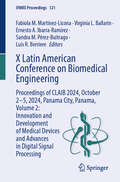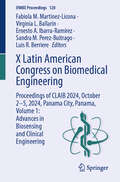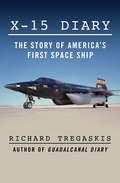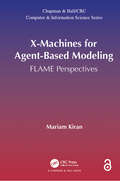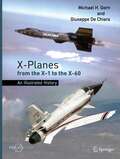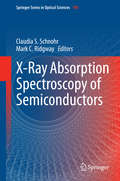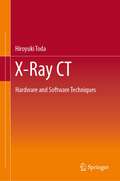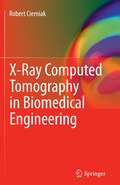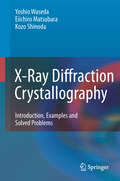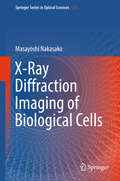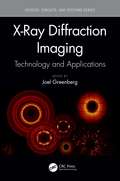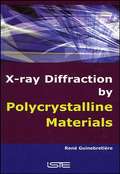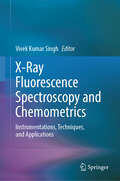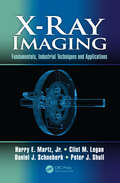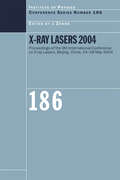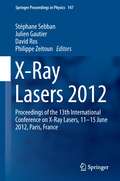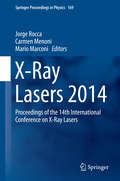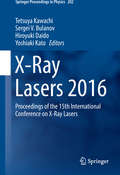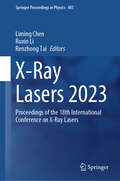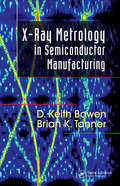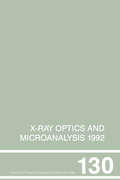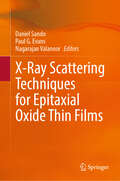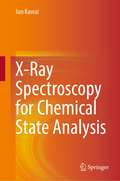- Table View
- List View
X Latin American Conference on Biomedical Engineering: Proceedings of CLAIB 2024, October 2-5, 2024, Panama City, Panama, Volume 2: Innovation and Development of Medical Devices and Advances in Digital Signal Processing (IFMBE Proceedings #121)
by Fabiola M. Martinez-Licona Virginia L. Ballarin Ernesto A. Ibarra-Ramírez Sandra M. Pérez-Buitrago Luis R. BerriereThis book reports on the latest research and developments in Biomedical Engineering, with a special emphasis on technologies transforming health in Latin America. This second volume of a 2-volume set covers advances in the development of assistive, therapeutic, and diagnostic devices, and cutting-edge methods for biological signal acquisition and analysis. Throughout the book, a special emphasis is given to low-cost affordable technologies and to their development for and applications in clinical settings. Based on the X Latin American Conference on Biomedical Engineering (CLAIB 2024) held on October 2-5, 2024, in Panama City, Panama, this book provides researchers and professionals in the biomedical engineering field with extensive information on new technologies and current challenges for their clinical applications.
X Latin American Congress on Biomedical Engineering: Proceedings of CLAIB 2024, October 2-5, 2024, Panama City, Panama, Volume 1: Advances in Biosensing and Clinical Engineering (IFMBE Proceedings #120)
by Fabiola M. Martinez-Licona Virginia L. Ballarin Ernesto A. Ibarra-Ramírez Luis R. Berriere Sandra M. Perez-BuitragoThis book reports on the latest research and developments in Biomedical Engineering, with a special emphasis on technologies transforming health in Latin America. This first volume of a 2-volume set covers advances in biosciences, robotics, biosensors and clinical engineering. Throughout the book, a special emphasis is given to low-cost affordable technologies and to their development for and applications in clinical settings. Based on the X Latin American Conference on Biomedical Engineering (CLAIB 2024) held on October 2-5, 2024, in Panama City, Panama, this book provides researchers and professionals in the biomedical engineering field with extensive information on new technologies and current challenges for their clinical applications.
X-15 Diary: The Story of America's First Space Ship
by Richard TregaskisThe riveting true story of the world&’s fastest plane and the first manned flights into outer space. First tested in 1959, the X-15 rocket plane was at the forefront of the space race. Developed by the US Air Force and the National Aeronautics and Space Administration (NASA) in collaboration with North American Aviation, the X-15 was sleek, black, and powerful—a missile with stubby wings and a cockpit on the nose. By 1961 it could reach speeds over three thousand miles per hour and fly at an altitude of thirty-one miles above the earth&’s surface—the lower reaches of outer space. Acclaimed journalist and bestselling author Richard Tregaskis tells the story of the X-15&’s development through the eyes of the brave pilots and brilliant engineers who made it possible. From technological breakthroughs to disastrous onboard explosions to the bone-crushing effects of intense g-force levels, Tregaskis captures all the drama and excitement of this crucial proving ground for the Mercury, Gemini, and Apollo missions. X-15 Diary recounts a thrilling chapter in the history of the American space program and serves as a fitting tribute to the courageous scientists and adventurers who dared to go where no man had gone before. This ebook features an illustrated biography of Richard Tregaskis including rare images from the American Heritage Center at the University of Wyoming.
X-Machines for Agent-Based Modeling: FLAME Perspectives (Chapman & Hall/CRC Computer and Information Science Series)
by Mariam KiranFrom the Foreword: "This book exemplifies one of the most successful approaches to modeling and simulating [the] new generation of complex systems. FLAME was designed to make the building of large scale complex systems models straightforward and the simulation code that it generates is highly efficient and can be run on any modern technology. FLAME was the first such platform that ran efficiently on high performance parallel computers and a version for GPU technology is also available. At its heart, and the reason why it is so efficient and robust, is the use of a powerful computational model ‘Communicating X-machines’ which is general enough to cope with most types of modelling problems. As well as being increasingly important in academic research, FLAME is now being applied in industry in many different application areas. This book describes the basics of FLAME and is illustrated with numerous examples."—Professor Mike Holcombe, University of Sheffield, UK Agent-based models have shown applications in various fields such as biology, economics, and social science. Over the years, multiple agent-based modeling frameworks have been produced, allowing experts with non-computing background to easily write and simulate their models. However, most of these models are limited by the capability of the framework, the time it takes for a simulation to finish, or how to handle the massive amounts of data produced. FLAME (Flexible Large-scale Agent-based Modeling Environment) was produced and developed through the years to address these issues. This book contains a comprehensive summary of the field, covers the basics of FLAME, and shows how concepts of X-machines, can be stretched across multiple fields to produce agent models. It has been written with several audiences in mind. First, it is organized as a collection of models, with detailed descriptions of how models can be designed, especially for beginners. A number of theoretical aspects of software engineering and how they relate to agent-based models are discussed for students interested in software engineering and parallel computing. Finally, it is intended as a guide to developers from biology, economics, and social science, who want to explore how to write agent-based models for their research area. By working through the model examples provided, anyone should be able to design and build agent-based models and deploy them. With FLAME, they can easily increase the agent number and run models on parallel computers, in order to save on simulation complexity and waiting time for results. Because the field is so large and active, the book does not aim to cover all aspects of agent-based modeling and its research challenges. The models are presented to show researchers how they can build complex agent functions for their models. The book demonstrates the advantage of using agent-based models in simulation experiments, providing a case to move away from differential equations and build more reliable, close to real, models. The Open Access version of this book, available at https://doi.org/10.1201/9781315370729, has been made available under a Creative Commons Attribution-Non Commercial-No Derivatives 4.0 license.
X-Parameters
by David E. Root Jan Verspecht Jason Horn Mihai Marcu David E. Root Jan Verspecht Jason HornThis is the definitive guide to X-parameters, written by the original inventors and developers of this powerful new paradigm for nonlinear RF and microwave components and systems. Learn how to use X-parameters to overcome intricate problems in nonlinear RF and microwave engineering. The general theory behind X-parameters is carefully and intuitively introduced, and then simplified down to specific, practical cases, providing you with useful approximations that will greatly reduce the complexity of measuring, modeling and designing for nonlinear regimes of operation. Containing real-world case studies, definitions of standard symbols and notation, detailed derivations within the appendices, and exercises with solutions, this is the definitive stand-alone reference for researchers, engineers, scientists and students looking to remain on the cutting-edge of RF and microwave engineering.
X-Planes from the X-1 to the X-60: An Illustrated History (Springer Praxis Books)
by Michael H. Gorn Giuseppe De ChiaraForeword by Dr. Roger D. Launius, Former NASA Chief Historian For the past 75 years, the U.S. government has invested significant time and money into advanced aerospace research, as evidenced by its many experimental X-plane aircraft and rockets. NASA's X-Planes asks a simple question: What have we gained from it all? To answer this question, the authors provide a comprehensive overview of the X-plane’s long history, from the 1946 X-1 to the modern X-60. The chapters describe not just the technological evolution of these models, but also the wider story of politics, federal budgets, and inter-agency rivalries surrounding them. The book is organized into two sections, with the first covering the operational X-planes that symbolized the Cold War struggle between the U.S. and the U.S.S.R, and the second section surveying post-Cold War aircraft and spacecraft. Featuring dozens of original illustrations of X-plane cross-sections, in-flight profiles, close-ups, and more, this book will educate general readers and specialists alike.
X-Ray Absorption Spectroscopy of Semiconductors
by Claudia S. Schnohr Mark C. RidgwayX-ray Absorption Spectroscopy (XAS) is a powerful technique with which to probe the properties of matter, equally applicable to the solid, liquid and gas phases. Semiconductors are arguably our most technologically-relevant group of materials given they form the basis of the electronic and photonic devices that now so widely permeate almost every aspect of our society. The most effective utilisation of these materials today and tomorrow necessitates a detailed knowledge of their structural and vibrational properties. Through a series of comprehensive reviews, this book demonstrates the versatility of XAS for semiconductor materials analysis and presents important research activities in this ever growing field. A short introduction of the technique, aimed primarily at XAS newcomers, is followed by twenty independent chapters dedicated to distinct groups of materials. Topics span dopants in crystalline semiconductors and disorder in amorphous semiconductors to alloys and nanometric material as well as in-situ measurements of the effects of temperature and pressure. Summarizing research in their respective fields, the authors highlight important experimental findings and demonstrate the capabilities and applications of the XAS technique. This book provides a comprehensive review and valuable reference guide for both XAS newcomers and experts involved in semiconductor materials research.
X-Ray CT: Hardware and Software Techniques
by Hiroyuki TodaThis book provides easy-to-understand explanations to systematically and comprehensively describe the X-ray CT technologies, techniques, and skills used for industrial and scientific purposes. Included are many references along with photographs, figures, and equations prepared by the author. These features all facilitate the reader's gaining a deeper understanding of the topics being discussed. The book presents expertise not only on fundamentals but also about hardware, software, and analytical methods for the benefit of technical users. The book targets engineers, researchers, and students who are involved in research, development, design, and quality assurance in industry and academia.
X-Ray Computed Tomography in Biomedical Engineering
by Robert CierniakComputed Tomography gives a detailed overview of various aspects of computed tomography. It discusses X-ray CT tomography from a historical point of view, the design and physical operating principles of computed tomography apparatus, the algorithms of image reconstruction and the quality assessment criteria of tomography scanners. Algorithms of image reconstruction from projections, a crucial problem in medical imaging, are considered in depth. The author gives descriptions of the reconstruction methods related to tomography scanners with a parallel X-ray beam, trough solutions with fan-shaped beam and successive modifications of spiral scanners. Computed Tomography contains a dedicated chapter for those readers who are interested in computer simulations based on studies of reconstruction algorithms. The information included in this chapter will enable readers to create a simulation environment in which virtual tomography projections can be obtained in all basic projection systems. This monograph is a valuable study on computed tomography that will be of interest to advanced students and researchers in the fields of biomedical engineering, medical electronics, computer science and medicine.
X-Ray Diffraction Crystallography
by Eiichiro Matsubara Kozo Shinoda Yoshio WasedaX-ray diffraction crystallography for powder samples is a well-established and widely used method. It is applied to materials characterization to reveal the atomic scale structure of various substances in a variety of states. The book deals with fundamental properties of X-rays, geometry analysis of crystals, X-ray scattering and diffraction in polycrystalline samples and its application to the determination of the crystal structure. The reciprocal lattice and integrated diffraction intensity from crystals and symmetry analysis of crystals are explained. To learn the method of X-ray diffraction crystallography well and to be able to cope with the given subject, a certain number of exercises is presented in the book to calculate specific values for typical examples. This is particularly important for beginners in X-ray diffraction crystallography. One aim of this book is to offer guidance to solving the problems of 90 typical substances. For further convenience, 100 supplementary exercises are also provided with solutions. Some essential points with basic equations are summarized in each chapter, together with some relevant physical constants and the atomic scattering factors of the elements.
X-Ray Diffraction Imaging of Biological Cells (Springer Series In Optical Sciences #210)
by Masayoshi NakasakoProvides the first book on coherent X-ray diffraction imaging technique using the X-ray free electron laser SACLA in Japan written by a leader in the field.<P><P> Introduces the history, theory and computational simulation regarding of coherent X-ray diffraction imaging.<P> Describes experimental setups developed by the author, as well as modelling software to analyze the data.<P> In this book, the author describes the development of the experimental diffraction setup and structural analysis of non-crystalline particles from material science and biology. Recent advances in X-ray free electron laser (XFEL)-coherent X-ray diffraction imaging (CXDI) experiments allow for the structural analysis of non-crystalline particles to a resolution of 7 nm, and to a resolution of 20 nm for biological materials. Now XFEL-CXDI marks the dawn of a new era in structural analys of non-crystalline particles with dimensions larger than 100 nm, which was quite impossible in the 20th century.<P> To conduct CXDI experiments in both synchrotron and XFEL facilities, the author has developed apparatuses, named KOTOBUKI-1 and TAKASAGO-6 for cryogenic diffraction experiments on frozen-hydrated non-crystalline particles at around 66 K. At the synchrotron facility, cryogenic diffraction experiments dramatically reduce radiation damage of specimen particles and allow tomography CXDI experiments. In addition, in XFEL experiments, non-crystalline particles scattered on thin support membranes and flash-cooled can be used to efficiently increase the rate of XFEL pulses. The rate, which depends on the number density of scattered particles and the size of X-ray beams, is currently 20-90%, probably the world record in XFEL-CXDI experiments. The experiment setups and results are introduced in this book. The author has also developed software suitable for efficiently processing of diffraction patterns and retrieving electron density maps of specimen particles based on the diffraction theory used in CXDI.
X-Ray Diffraction Imaging: Technology and Applications (Devices, Circuits, and Systems)
by Joel GreenbergThis book explores novel methods for implementing X-ray diffraction technology as an imaging modality, which have been made possible through recent breakthroughs in detector technology, computational power, and data processing algorithms. The ability to perform fast, spatially-resolved X-ray diffraction throughout the volume of a sample opens up entirely new possibilities in areas such as material analysis, cancer diagnosis, and explosive detection, thus offering the potential to revolutionize the fields of medical, security, and industrial imaging and detection. Featuring chapters written by an international selection of authors from both academia and industry, the book provides a comprehensive discussion of the underlying physics, architectures, and applications of X-ray diffraction imaging that is accessible and relevant to neophytes and experts alike. Teaches novel methods for X-ray diffraction imaging Comprehensive and self-contained discussion of the relevant physics, imaging techniques, system components, and data processing algorithms Features state-of-the-art work of international authors from both academia and industry. Includes practical applications in the medical, industrial, and security sectors
X-Ray Diffraction by Polycrystalline Materials
by René GuinebretièreThis book presents a physical approach to the diffraction phenomenon and its applications in materials science. An historical background to the discovery of X-ray diffraction is first outlined. Next, Part 1 gives a description of the physical phenomenon of X-ray diffraction on perfect and imperfect crystals. Part 2 then provides a detailed analysis of the instruments used for the characterization of powdered materials or thin films. The description of the processing of measured signals and their results is also covered, as are recent developments relating to quantitative microstructural analysis of powders or epitaxial thin films on the basis of X-ray diffraction. Given the comprehensive coverage offered by this title, anyone involved in the field of X-ray diffraction and its applications will find this of great use.
X-Ray Fluorescence Spectroscopy and Chemometrics: Instrumentations, Techniques, and Applications
by Vivek Kumar SinghThis book delves into X-ray fluorescence (XRF) spectroscopy, focusing on instrumental developments and data analysis methods employing chemometrics for environmental applications. The integration of information from multiple datasets is gaining an increase in attention and significance in the environmental sciences. In this book, the contributors provide an up-to-date treatment of the most extensively used chemometric methods for predicting and interpreting spectroscopic data in environmental applications. This book describes recent trends in XRF spectroscopic methods, encompassing energy-dispersive and wavelength-dispersive X-ray fluorescence, synchrotron radiation-based XRF, micro-XRF, and total reflection-XRF. It delivers a comprehensive discussion on X-ray detectors and associated imaging applications, along with an exploration of the analytical capabilities of these methods, including detection limits, accuracy, and precision in measurements for environmental samples. Furthermore, this book discusses the numerous advantages and limitations of these techniques, highlighting the latest developments in algorithms based on machine learning, neural networks, and AI for spectroscopic data interpretation. This book caters to researchers across various branches of science and technology, aiming to introduce them to modern techniques coupled with advanced data analysis methods. It serves as a valuable reference for those engaged in XRF spectroscopy techniques, hyphenated XRF spectroscopic techniques, and the characterization of biomolecular systems and environmental samples.
X-Ray Imaging: Fundamentals, Industrial Techniques and Applications
by Peter J. Shull Harry E. Martz Clint M. Logan Daniel J. SchneberkWhile books on the medical applications of x-ray imaging exist, there is not one currently available that focuses on industrial applications. Full of color images that show clear spectrometry and rich with applications, X-Ray Imaging fills the need for a comprehensive work on modern industrial x-ray imaging. It reviews the fundamental science of x-ray imaging and addresses equipment and system configuration. Useful to a broad range of radiation imaging practitioners, the book looks at the rapid development and deployment of digital x-ray imaging system.
X-Ray Lasers 1996: Proceedings of the Fifth International Conference on X-Ray Lasers held in Lund, Sweden, 10-14 June, 1996
by S Svanberg; C-G WahlströmX-Ray Lasers 1996 provides not only an overview and progress report on this fast moving field, but also important reference material on which future work can be built. Topics covered include collisional x-ray lasers, table-top x-ray lasers, beam optics, x-ray optics, OFI and photo-pumped schemes, capillary schemes, international laser facilities, XUV nonlinear mixing, alternative soft x-ray sources, diagnostics, and applications. The volume is an essential addition to the libraries of researchers in the field.
X-Ray Lasers 2004 (Institute of Physics Conference Series)
by Jie ZhangX-Ray Lasers 2004 comprises invited, contributed, and poster papers presented at the 9th International Conference on X-Ray Lasers (ICXRL2004) held in Beijing in May 2004. Some 120 participants from 13 countries and regions met in Beijing to compare results and exchange views on future developments in x-ray lasers and related fields.The book
X-Ray Lasers 2012
by Stéphane Sebban Julien Gautier David Ros Philippe ZeitounThese proceedings comprise of invited and contributed papers presented at the 13th International Conference on X-Ray Lasers (ICXRL 2012) which was held 11-15 June 2012 in Paris, France, in the famous Quartier Latin, inside the historical Center of Cordeliers. This conference is part of a continuing series dedicated to recent developments and applications of x-ray lasers and other coherent x-ray sources with attention to supporting technologies and instrumentation. New results in the generation of intense coherent x-rays and progress towards practical devices and their applications are reported in these proceedings, including areas of research in plasma-based x-ray lasers, 4th generation accelerator-based sources and higher harmonic generation. Recent achievements related to the increase of the repetition rate up to 100 Hz and shorter wavelength collisional plasma-based soft x-ray lasers down to about 7 nm are presented. Seeding the amplifying plasma with a femtosecond high-order harmonic of infrared laser was foreseen as the required breakthrough to break the picosecond frontier. Numerical simulations based on the Maxwell-Bloch model are presented in these proceedings, transposing the chirped pulse amplification technique to the x-ray domain in order to increase the time over which the femtosecond seed can be amplified. These proceedings also include innovative applications of soft x-ray lasers based on techniques and diagnostics relevant to topical domains such as EUV lithography, inertial confinement fusion, or warm dense matter physics.
X-Ray Lasers 2014
by Jorge Rocca Carmen Menoni Mario MarconiThese proceedings comprise invited and contributed papers presented at the 14th International Conference on X-Ray Lasers (ICXRL 2014). This conference is part of a continuing series dedicated to recent developments and applications of x-ray lasers and other coherent x-ray sources with attention to supporting technologies and instrumentation. New results in the generation of intense, coherent x-rays and progress toward practical devices and their applications in numerous fields are reported. Areas of research in plasma-based x-ray lasers, 4th generation accelerator-based sources and higher harmonic generation, and other x-ray generation schemes are covered. The scope of ICXRL 2014 included, but was not limited to: Laser-pumped X-ray lasers Discharge excitation and other X-ray laser pumping methods Injection/seeding of X-ray amplifiers New lasing transitions and novel X-ray laser schemes High Harmonic sources-Free-electron laser generation in the XUV and X-ray range Novel schemes for coherent XUV and X-ray generation XUV and X-ray optics and metrology-Driving laser technology Theory and modeling of X-ray gain medium and beam characteristics Applications of high brightness and ultrashort X-ray sources
X-Ray Lasers 2016: Proceedings Of The 15th International Conference On X-ray Lasers (Springer Proceedings In Physics #202)
by Tetsuya Kawachi Sergei V. Bulanov Hiroyuki Daido Yoshiaki KatoDiscusses the latest research topics related to coherent x-ray sources.<P><P> Includes several new proposals for free-electron laser (FEL) using laser- accelerated electrons.<P> Describes the latest methodology and techniques for x-ray coherent diffraction imaging and x-ray interferometry.<P> These proceedings comprise a selection of invited and contributed papers presented at the 15th International Conference on X-Ray Lasers (ICXRL 2016), held at the Nara Kasugano International Forum, Japan, from May 22 to 27, 2016. This conference was part of an ongoing series dedicated to recent developments in the science and technology of x-ray lasers and other coherent x-ray sources with additional focus on supporting technologies, instrumentation and applications. <P> The book showcases recent advances in the generation of intense, coherent x-rays, the development of practical devices and their applications across a wide variety of fields. It also discusses emerging topics such as plasma-based x-ray lasers, 4th generation accelerator-based sources and higher harmonic generations, as well as other x-ray generation schemes.
X-Ray Lasers 2023: Proceedings of the 18th International Conference on X-Ray Lasers (Springer Proceedings in Physics #403)
by Ruxin Li Liming Chen Renzhong TaiThese proceedings present a selection of invited and contributed papers presented during the 18th International Conference on X-Ray Lasers (the 18th ICXRL), held in Shanghai, China, from 17 to 21 July 2023. The conference is part of an ongoing series dedicated to recent developments in the science and technology of X-ray lasers and other coherent X-ray sources, with an additional focus on supporting technologies, instrumentation and applications. The book highlights advances in a wide range of fields including laser and discharge-pumped plasma X-ray lasers, the injection and seeding of X-ray amplifiers, high-order harmonic generation and ultrafast phenomena, X-ray free electron lasers, X-ray and gamma-ray generation, X-ray ghost imaging, optics and metrology, X-rays and γ-rays for fundamental science, the practical implementation of X-ray lasers, XFELs and super-intense lasers, and the applications and industrial uses of X-ray lasers.
X-Ray Metrology in Semiconductor Manufacturing
by D. Keith Bowen Brian K. TannerThe scales involved in modern semiconductor manufacturing and microelectronics continue to plunge downward. Effective and accurate characterization of materials with thicknesses below a few nanometers can be achieved using x-rays. While many books are available on the theory behind x-ray metrology (XRM), X-Ray Metrology in Semiconductor Manufacturing is the first book to focus on the practical aspects of the technology and its application in device fabrication and solving new materials problems. Following a general overview of the field, the first section of the book is organized by application and outlines the techniques that are best suited to each. The next section delves into the techniques and theory behind the applications, such as specular x-ray reflectivity, diffraction imaging, and defect mapping. Finally, the third section provides technological details of each technique, answering questions commonly encountered in practice. The authors supply real examples from the semiconductor and magnetic recording industries as well as more than 150 clearly drawn figures to illustrate the discussion. They also summarize the principles and key information about each method with inset boxes found throughout the text. Written by world leaders in the field, X-Ray Metrology in Semiconductor Manufacturing provides real solutions with a focus on accuracy, repeatability, and throughput.
X-Ray Optics and Microanalysis 1992, Proceedings of the 13th INT Conference, 31 August-4 September 1992, Manchester, UK
by P.B. Kenway P.J. DukeThe first ICXOM congress held in Cambridge was the brain-child of Dr. Ellis Cosslett, founder of the Electron Optics Section of the Cavendish Laboratory. Dr. Cosslett pioneered research in x-ray optics and microanalysis and retained a close interest in all subject applications for this area of research, including physics, materials science, chemistry, and biology. X-Ray Optics and Microanalysis 1992 was held in his memory. At a special symposium, friends and colleagues reviewed the present status of research in x-ray optics and microanalysis. S.J. Pennycook of Oak Ridge National Laboratory, D.B. Williams of Lehigh University, J.A. Venables et al. of Arizona State University and Sussex University, and C. Jacobsen et al. of SUNY, Stony Brook are among the researchers whose papers are included in this volume.
X-Ray Scattering Techniques for Epitaxial Oxide Thin Films
by Daniel Sando Paul G. Evans Nagarajan ValanoorThis book acts as a handbook on the topic of x-ray scattering as applied to epitaxial complex oxide films, providing detailed information to collect the data, how to analyze the data and the practical sides of the experiments. The first chapter considers laboratory-based X-ray diffraction (XRD) methods: the indispensable X-ray characterization methods used for phase analysis, epitaxial relationship determination, advanced analytical and data fitting techniques, and grazing incidence diffraction. The subsequent chapters focus on advanced techniques that are typically performed at large-scale facilities such as synchrotrons: diffuse scattering and strain mapping, coherent X-ray methods, magnetic X-ray scattering and dichroism effects, and pump-probe techniques. In addition, detailed characterization methods for complex structures such as oxide superlattices, the measurement of oxygen octahedra rotations, and probing of domain arrangements are covered. The overarching aim of the book is to provide a tutorial-style approach to assist experimentalists actually carrying out their experiments and data analysis. (For instance, the nitty gritty techniques of alignment and experimental setup, along with common mistakes and pitfalls, are often not discussed in textbooks or instruction manuals.). The book is an invaluable tool for the wide range of researchers working globally on &‘oxide electronics,&’ serves as a reference text for the many and varied techniques applied to such materials systems, and showcases new advanced methods in x-ray scattering.
X-Ray Spectroscopy for Chemical State Analysis
by Jun KawaiThis book focuses on X-ray spectroscopy for chemical state analysis covering X-ray physics, spectroscopic characteristics used for functional and toxic materials, and the author's ideas related to X-ray experiments. This book also provides novel theoretical interpretations of X-ray spectra along with experimental techniques needed for both synchrotron radiation users and laboratory experimentalists. Presenting not only practical information, this book also covers basic knowledge of commercially available spectrometers and the basic physics of optics and electromagnetism related to X-rays. Furthermore, the author introduces the forgotten history of X-ray physics in the beginning of twentieth century. This book is of use for researchers studying catalysts, charge-transfer materials, surface characterization, and toxic trace elements via X-ray spectroscopy for chemical state analysis as well as quantitative analysis.
